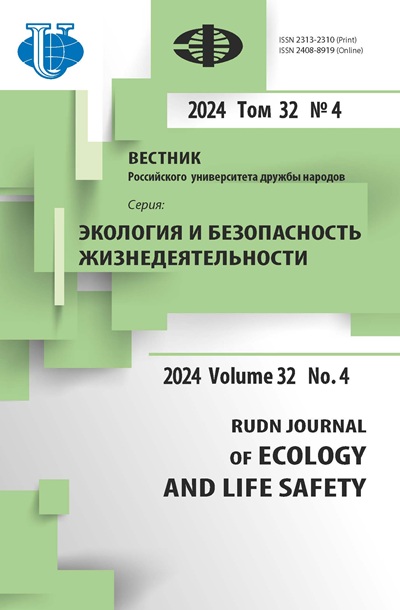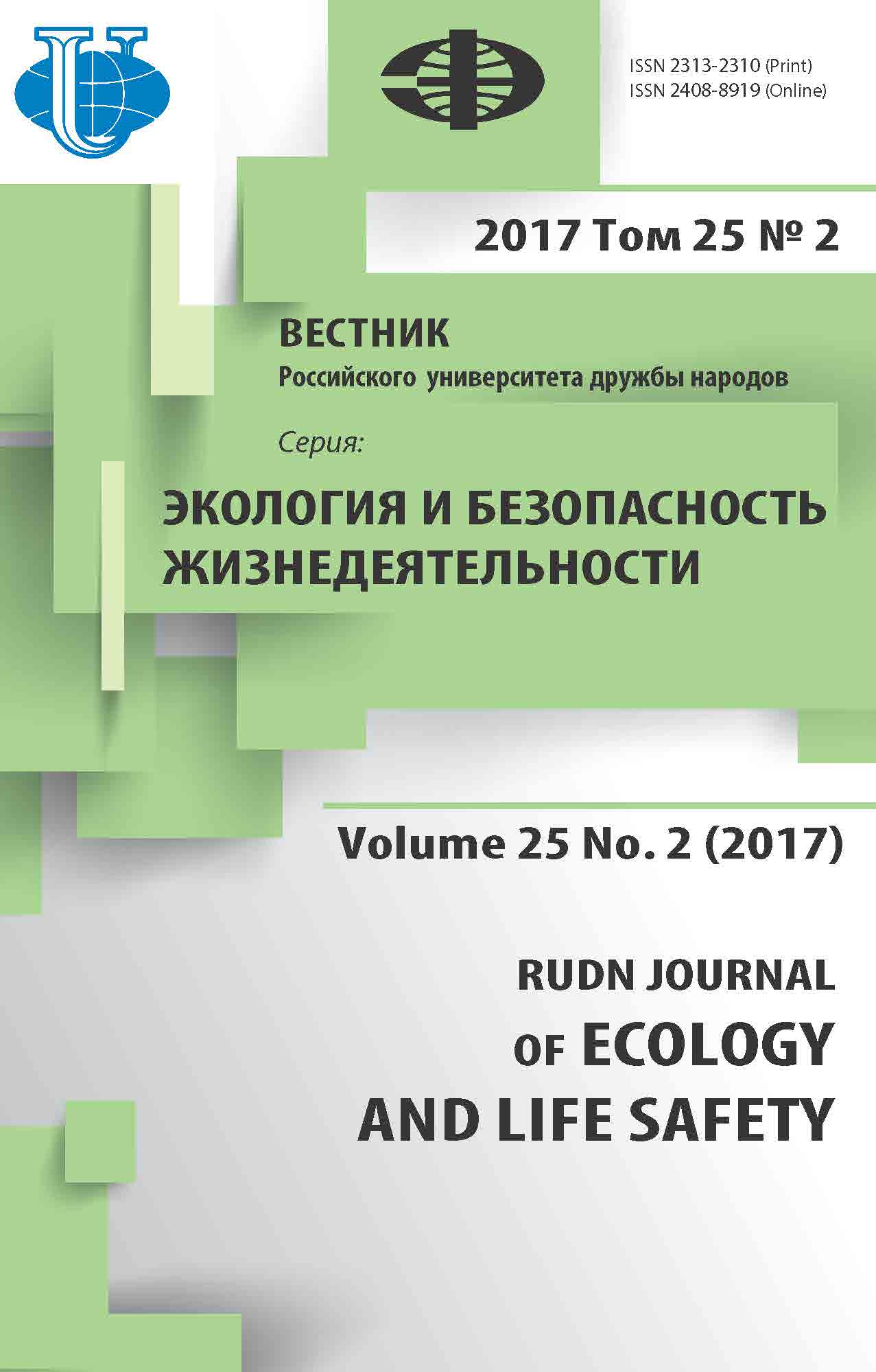TE MPORARY CHANGES IN POLYARENES CONTENT IN SOILS AND PLANTS UNDER THE INFLUENCE OF COAL MINING
- Authors: Yakovleva EV1, Gabov DN1, Beznosikov b.k.1
-
Affiliations:
- Institute of Biology of Komi Scientific Centre of the Ural Branch of the Russian Academy of Sciences
- Issue: Vol 25, No 2 (2017)
- Pages: 271-293
- Section: Articles
- URL: https://journals.rudn.ru/ecology/article/view/17189
- DOI: https://doi.org/10.22363/2313-2310-2017-25-2-271-293
Cite item
Full Text
Abstract
Rapid development of the industry causes intensified contamination of the environment with polycyclic aromatic hydrocarbons (PAHs). Tundra ecosystems have high recourse potential but also are characterized by a low resistance to anthropogenic influences. The aim of our research was to study possible use of organogenic soil horizons, plants and lichens to trace temporary changes in PAH content in south tundra communities under the aerotechnogenic pollution. Monitoring of PAH content was conducted in organogenic soil horizons and plants from lower vegetation layer of southern tundra. Soils and plants were sampled both from the вackground site and from the sites established in 0,5; 1 and 1,5 km north-east from the coal mine “Vorkutinskaya” taking into account the wind rose. The samples were collected at the polluted sites in 2013 and 2015. The model species - lichen Peltigera leucophlebia Nyl., moss Pleurozium schreberi Brid. and dwarf shrub Vaccinium myrtillus L. (leaves). ASE-350 accelerated solvent extraction system (Thermo Fisher Scientific, USA) was used to extract PAHs from plants and soils. PAH content in the sample was determined by HPLC method.13 PAH structures were identified in organogenic horizons, plants and lichens from the sites under study. Coal dust was found to be the main PAH source for soils and plants affected by the mine “Vorkutinskaya”. Light polyarenes made the greatest contribution to the total PAH content. Their proportion remained stable in time at different distances from the mine indicating the constant nature of the contamination. Decrease of PAH content in plants during the two-year period was caused by decrease of mine effect intensity. Plants responded on changes in PAH streams faster than soil organogenic horizons. So, we suppose that plants can be used as better indicators of environmental changes. The largest level of PAH accumulation was revealed for moss Pleurozium schreberi, which due to its wide spread and active PAH accumulation ability can be used to indicate the contamination level in zones affected by coal mining industry.
Keywords
About the authors
E V Yakovleva
Institute of Biology of Komi Scientific Centre of the Ural Branch of the Russian Academy of Sciences
Author for correspondence.
Email: kaleeva@ib.komisc.ru
Yakovleva Evgenia Vyacheslavovna - Ph.D., research assistant, Department of Soil Science of the Federal State Budgetary Science Institution of the Institute of Biology of the Komi Scientific Center of the Ural Branch of the Russian Academy of Sciences.
Kommunisticheskaya str., 28, Syktyvkar, Komi Republic, Russia, 167982D N Gabov
Institute of Biology of Komi Scientific Centre of the Ural Branch of the Russian Academy of Sciences
Email: gabov@ib.komisc.ru
Gabov Dmitry Nikolayevich - Ph.D., research assistant, Ecoanalytical laboratory of the Federal State Budgetary Science Institution of the Institute of Biology of the Komi Scientific Center of the Ural Branch of the Russian Academy of Sciences.
Kommunisticheskaya str., 28, Syktyvkar, Komi Republic, Russia, 167982beznosikov@ib komiscr Beznosikov
Institute of Biology of Komi Scientific Centre of the Ural Branch of the Russian Academy of Sciences
Email: beznosikov@ib.komisc.ru
Beznosikov Vasily Alexandrovich - Doctor of chemical sciences, Head of the soil chemistry laboratory of the Soil Science Department of the Federal State Budgetary Institute of Science of the Institute of Biology of the Komi Scientific Center of the Ural Branch of the Russian Academy of Sciences.
Kommunisticheskaya str., 28, Syktyvkar, Komi Republic, Russia, 167982References
- Abakumov E.V., Lodygin E.D., Gabov D.A., Krylenkov V.A. Polycyclic aromatic hydrocarbons content in Antarctica soils as exemplified by the Russian polar stations. Hygiene and sanitation. 2014; 1: 30—34. (In Russ).
- Cvetković А., Jovašević-Stojanović M., Matić-Besarabić S., Marković D.A., Bartoňová A. Comparison of sources of urban ambient particle bound pahs between non-heating seasons 2009 and 2012 in Belgrade, Serbia. Chem. Ind. Chem. Eng. Q. 2015; 21 (1): 211—219. doi: 10.2298/CICEQ140305033C
- Nguyen H.T., Kim K.-H., Ma C.-J., Oh J.-M.. Polycyclic Aromatic Hydrocarbon Concentration Levels on the Korean Peninsula between 2006 and 2008. The Scientific World JOURNAL. 2010; 10: 20—37. doi: 10.1100/tsw.2010.5
- Kosheleva N.E., Nikiforova E.M. Interannual dynamics and factors of benzo(a)pyrene accumulation in urban soils (eastern administrative district of Moscow as a case study). MSU Vestnik. Series 17. Soil Sciense. 2011; 2: 25—34. (In Russ).
- Sushkova S.N., Minkina T.M., Mandzhieva S.S., Tyurina I.G., Vasil’eva G.K., Kızılkaya R. Monitoring of Benzo[a]pyrene Content in Soils Affected by the Long-Term Technogenic Contamination. Eurasian Soil Science. 2017; 50 (1): 95—105. doi: 10.1134/S1064229317010148
- Kim S.-K., Lee D.S., Shim W.J., Yim U.H., Shin Y.-S. Interrelationship of Pyrogenic Polycyclic Aromatic Hydrocarbon (PAH) Contamination in Different Environmental Media. Sensors. 2009; 9: 9582—9602. doi: 10.3390/s91209582
- Wu Q., Wang X., Zhou Q. Biomonitoring persistent organic pollutants in the atmosphere with mosses: Performance and application. Environment International. 2014; 66: 28—37. doi: 10.1016/j.envint.2013.12.021
- Iodice P., Adamo P., Capozzi F., Di Palma A., Senatore A., Spagnuolo V., Giordano S. Air pollution monitoring using emission inventories combined with the moss bag approach. Science of the total environment. 2016; 541: 1410—1419. doi: 10.1016/j.scitotenv.2015.10.034
- Zhang Y.F., Shotyk W., Zaccone C., Noernberg T., Pelletier R., Bicalho B., Froese D.G., Davies L., Martin J.W. Airborne Petcoke Dust is a Major Source of Polycyclic Aromatic Hydrocarbons in the Athabasca Oil Sands Region. Environmental science & technology. 2016; 50(4): 1711—1720. doi: 10.1021/acs.est.5b05092
- Vingiani S., De Nicola F., Purvis W.O., Concha-Grana E., Muniategui-Lorenzo S., Lopez-Mahia P., Giordano S., Adamo P. Active Biomonitoring of Heavy Metals and PAHs with Mosses and Lichens: a Case Study in the Cities of Naples and London. Water air and soil pollution. 2015; 226 (8): 240. 35400062635876.0010.
- Foan L., Domercq M., Bermejo R., Santamaria J.M., Simon V. Mosses as an integrating tool for monitoring PAH atmospheric deposition: Comparison with total deposition and evaluation of bioconcentration factors. A year-long case-study. Chemosphere. 2015; 119: 452—458. doi: 10.1016/j.chemosphere.2014.06.071
- Kodnik D., Carniel F.C., Licen S., Tolloi A., Barbieri P., Tretiach M. Seasonal variations of PAHs content and distribution patterns in a mixed land use area: A case study in NE Italy with the transplanted lichen Pseudevernia furfuracea. Atmospheric environment. 2015; 113: 255—263. http://doi.org/10.1016/j.atmosenv.2015.04.067
- Mizwar A., Trihadiningrum Y. PAH Contamination in Soils Adjacent to a Coal-Transporting Facility in Tapin District, South Kalimantan, Indonesia. Arch. Environ. Contam. Toxicol. 2015; 69: 62—68. doi: 10.1007/s00244-015-0141-z
- Huang H., Xing X., Zhang Z., Qi S., Yang D., Yuen D.A., Sandy E.H., Zhou A., Li X. Polycyclic aromatic hydrocarbons (PAHs) in multimedia environment of Heshan coal district, Guangxi: distribution, source diagnosis and health risk assessment. Environ. Geochem. Health. 2016; 38: 1169—1181. doi: 10.1007/s10653-015-9781-1
- Khaustov A.P., Redina M.M. Transformation of petroleum products as source of natural habitat’s toxic contaminants. Ekologiya i promyshlennost’ Rossii. 2012; 12: 38—44. (In Russ).
- Yakovleva E.V., Gabov D.N., Beznosikov V.A., Kondratenok B.M. Polycyclic Aromatic Hydrocarbons in Soils and Lower-Layer Plants of the Southern Shrub Tundra under Technogenic Conditions. Eurasian Soil Sci. 2014; 47 (6): 562—572. doi: 10.1134/S1064229314060106
- Atlas pochv Respubliki Komi / Ed. A.I. Taskaev. Syktyvkar: Respublikanskoe izdatel’skoe agentstvo Komi, 2010. 356 s. (in Russian).
- Atlas Respubliki Komi po klimatu i gidrologii / Ed. A,I. Taskaev. Moscow: DiK, Drofa, 1997. 116 s. (In Russ).
- Beznosikov V.A., Lodygin E.D. Fraction-group humus composition of cryogenic surface-gley and hydromorphic soils of the Bolshezemelskaya tundra. Vestnik SPbSU. Biology. 2012; 3 (1): 107—120. (In Russ).
- Yakovleva E.V., Gabov D.N., Beznosikov V.A., Kondratenok B.M. Accumulation of Polycyclic Aromatic Hydrocarbons in Soils and Plants of the Tundra Zone under the Impact of Coal-Mining Industry. Eurasian Soil Science. 2016; 49 (11): 1319—1328. doi: 10.7868/S0032180X16090148
- Skert N., Falomo J., Giorgini L., Acquavita A., Capriglia L., Grahonja R., et al. Biological and artificial matrixes as PAH accumulators: an experimental comparative. Water Air Soil Pollut. 2010; 206(1): 95—103. doi: 10.1007/s11270-009-0089-6
- Elin E.S. Fenol’nye soedineniya v biosfere. Novosibirsk: Izd-vo SO RAN, 2001. 392 s.
Statistics
Views
Abstract: 930
PDF (Russian): 430















